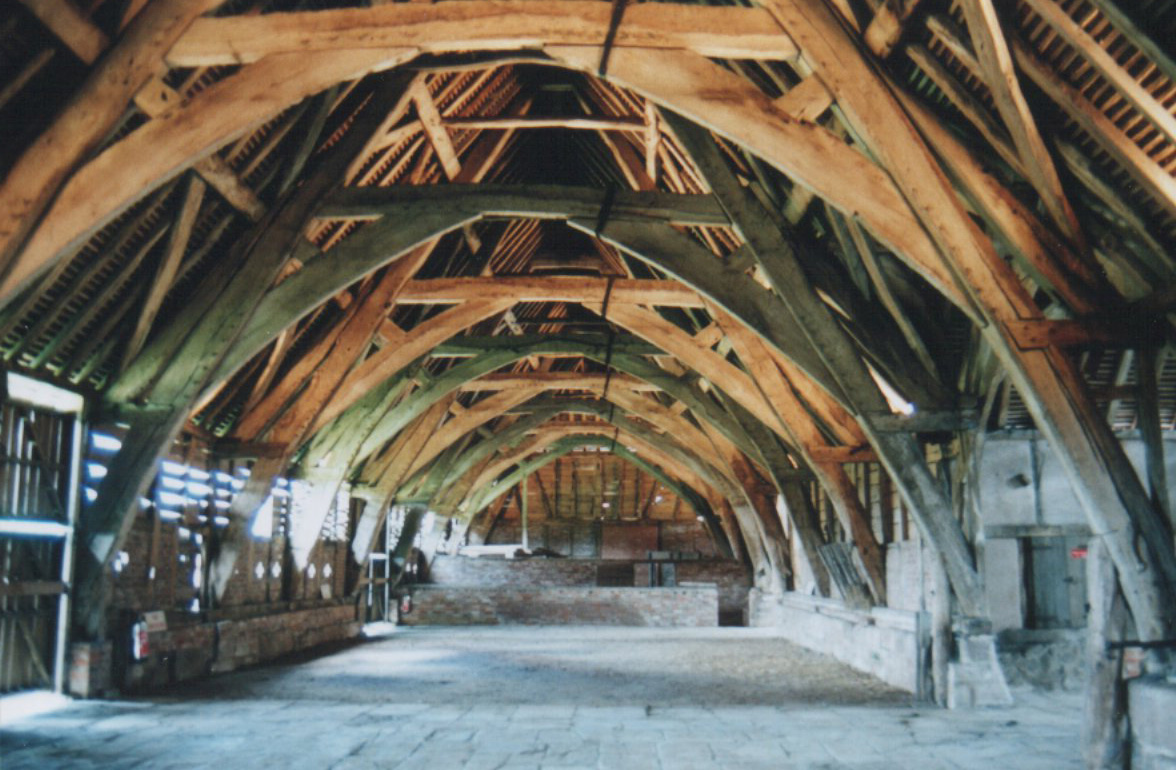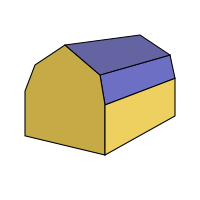|
Rafters
A rafter is one of a series of sloped structural members such as wooden beams that extend from the ridge or hip to the wall plate, downslope perimeter or eave, and that are designed to support the roof shingles, roof deck and its associated loads. A pair of rafters is called a ''couple''. In home construction, rafters are normally made of wood. Exposed rafters are a feature of some traditional roof styles. Applications In recent buildings there is a preference for trussed rafters on the grounds of cost, economy of materials, off-site manufacture, and ease of construction, as well as design considerations including span limitations and roof loads (weight from above). Types in traditional timber framing There are many names for rafters depending on their location, shape, or size (see below). The earliest surviving roofs in Europe are of common rafters on a tie beam; this assembly is known as a "closed couple". Later, principal rafters and common rafters were mixed, which is ... [...More Info...] [...Related Items...] OR: [Wikipedia] [Google] [Baidu] |
Purlin
A purlin (or historically purline, purloyne, purling, perling) is a longitudinal, horizontal, structural member in a roof. In traditional timber framing there are three basic types of purlin: purlin plate, principal purlin, and common purlin. Purlins also appear in steel frame construction. Steel purlins may be painted or greased for protection from the environment. Etymology Information on the origin of the term "purlin" is scant. The Oxford Dictionary suggests a French origin, with the earliest quote using a variation of ''purlin'' in 1447, though the accuracy of this claim has been disputed. In wood construction Purlin plate A purlin plate in wood construction is also called an "arcade plate" in European English, "under purlin", and "principal purlin". The term plate means a major, horizontal, supporting timber. Purlin plates are beams which support the mid-span of rafters and are supported by posts. By supporting the rafters they allow longer spans than the rafters alone ... [...More Info...] [...Related Items...] OR: [Wikipedia] [Google] [Baidu] |
Collar Beam
A collar beam or collar is a horizontal member between two rafters and is very common in domestic roof construction. Often a collar is structural but they may be used simply to frame a ceiling. A collar beam is often called a collar tie but this is rarely correct. A tie in building construction is an element in tension rather than compression and most collar beams are designed to work in compression to keep the rafters from sagging. A collar near the bottom of the rafters may replace a tie beam and be designed to keep the rafters from spreading, thus are in tension: these are correctly called a collar tie. Etymology ''Collar'' in general comes from Latin ''collare'' meaning neck. Collar beam roofs The simplest form of roof framing is a common rafter roof. This roof framing has nothing but rafters and a tie beam at the bottoms of the rafters. The next step in the development of roof framing was to add a collar, called a collar beam roof. Collar beam roofs are suitable for spans ... [...More Info...] [...Related Items...] OR: [Wikipedia] [Google] [Baidu] |
Tie Beam
A tie, strap, tie rod, eyebar, guy-wire, suspension cables, or wire ropes, are examples of linear structural components designed to resist tension. It is the opposite of a strut or column, which is designed to resist compression. Ties may be made of any tension resisting material. Application in wood construction In wood-frame construction ties are generally made of galvanized steel. Wood framing ties generally have holes allowing them to be fastened to the wood structure by nails or screws. The number and type of nails are specific to the tie and its use. The manufacturer generally specifies information as to the connection method for each of their products. Among the most common wood framing ties used is the hurricane tie or seismic tie used in the framing of wooden structures where wind uplift or seismic overturning is a concern. Hurricane tie A hurricane tie is used to help make a structure (specifically wooden structures) more resistant to high winds (such as in hurr ... [...More Info...] [...Related Items...] OR: [Wikipedia] [Google] [Baidu] |
Cruck
A cruck or crook frame is a curved timber, one of a pair, which support the roof of a building, historically used in England and Wales. This type of timber framing consists of long, generally naturally curved, timber members that lean inwards and form the ridge of the roof. These posts are then generally secured by a horizontal beam which then forms an "A" shape. Several of these "crooks" are constructed on the ground and then lifted into position. They are then joined together by either solid walls or cross beams which aid in preventing 'racking' (the action of each individual frame going out of square with the rest of the frame, and thus risking collapse). Etymology The term ''crook'' or ''cruck'' comes from Middle English ', from Old Norse ', meaning "hook". This is also the origin of the word "crooked", meaning bent, twisted or deformed, and also the crook used by shepherds and symbolically by bishops. Use Crucks were chiefly used in the medieval period for structures s ... [...More Info...] [...Related Items...] OR: [Wikipedia] [Google] [Baidu] |
Hip Roof
A hip roof, hip-roof or hipped roof, is a type of roof where all sides slope downwards to the walls, usually with a fairly gentle slope (although a tented roof by definition is a hipped roof with steeply pitched slopes rising to a peak). Thus, a hipped roof has no gables or other vertical sides to the roof. A square hip roof is shaped like a pyramid. Hip roofs on houses may have two triangular sides and two trapezoidal ones. A hip roof on a rectangular plan has four faces. They are almost always at the same pitch or slope, which makes them symmetrical about the centerlines. Hip roofs often have a consistent level fascia, meaning that a gutter can be fitted all around. Hip roofs often have dormer slanted sides. Construction Hip roofs are more difficult to construct than a gabled roof, requiring more complex systems of rafters or trusses. Hip roofs can be constructed on a wide variety of plan shapes. Each ridge is central over the rectangle of the building below it. Th ... [...More Info...] [...Related Items...] OR: [Wikipedia] [Google] [Baidu] |
Truss
A truss is an assembly of ''members'' such as beams, connected by ''nodes'', that creates a rigid structure. In engineering, a truss is a structure that "consists of two-force members only, where the members are organized so that the assemblage as a whole behaves as a single object". A "two-force member" is a structural component where force is applied to only two points. Although this rigorous definition allows the members to have any shape connected in any stable configuration, trusses typically comprise five or more triangular units constructed with straight members whose ends are connected at joints referred to as '' nodes''. In this typical context, external forces and reactions to those forces are considered to act only at the nodes and result in forces in the members that are either tensile or compressive. For straight members, moments ( torques) are explicitly excluded because, and only because, all the joints in a truss are treated as revolutes, as is necessary f ... [...More Info...] [...Related Items...] OR: [Wikipedia] [Google] [Baidu] |
Gambrel
A gambrel or gambrel roof is a usually symmetrical two-sided roof with two slopes on each side. (The usual architectural term in eighteenth-century England and North America was "Dutch roof".) The upper slope is positioned at a shallow angle, while the lower slope is steep. This design provides the advantages of a sloped roof while maximizing headroom inside the building's upper level and shortening what would otherwise be a tall roof. The name comes from the Medieval Latin word ''gamba'', meaning horse's hock or leg. The term ''gambrel'' is of American origin, the older, European name being a curb (kerb, kirb) roof. Europeans historically did not distinguish between a gambrel roof and a mansard roof but called both types a mansard. In the United States, various shapes of gambrel roofs are sometimes called Dutch gambrel or Dutch Colonial gambrel with bell-cast eaves, Swedish, German, English, French, or New England gambrel. The cross-section of a gambrel roof is similar to t ... [...More Info...] [...Related Items...] OR: [Wikipedia] [Google] [Baidu] |
Eave
The eaves are the edges of the roof which overhang the face of a wall and, normally, project beyond the side of a building. The eaves form an overhang to throw water clear of the walls and may be highly decorated as part of an architectural style, such as the Chinese dougong bracket systems. Etymology and usage According to the ''Oxford English Dictionary'', ''eaves'' is derived from the Old English (singular), meaning "edge", and consequently forms both the singular and plural of the word. This Old English word is itself of Germanic origin, related to the German dialect ''Obsen'', and also probably to ''over''. The Merriam-Webster dictionary lists the word as ''eave'' but notes that it is "usually used in plural". Function The primary function of the eaves is to keep rain water off the walls and to prevent the ingress of water at the junction where the roof meets the wall. The eaves may also protect a pathway around the building from the rain, prevent erosion of the foot ... [...More Info...] [...Related Items...] OR: [Wikipedia] [Google] [Baidu] |
Wall Plate
A plate or wall plate is a horizontal, structural, load-bearing member in wooden building framing. Timber framing A plate in timber framing is "A piece of Timber upon which some considerable weight is framed...Hence Ground-Plate...Window-plate bsolete.." etc. Also called a wall plate, raising plate,Sturgis, Russell. ''Sturgis' illustrated dictionary of architecture and building: an unabridged reprint of the 1901-2 edition''. 1901. Reprint. Mineola, N.Y.: Dover, 1989. 159. Print. or top plate,Sherwood, Gerald E., and Robert C. Stroh. ''Wood-frame house construction''. Washington, D.C.: U.S. Dept. of Agriculture, Forest Service :, 1989. 54. Print. An exception to the use of the term plate for a large, load-bearing timber in a wall is the bressummer, a timber supporting a wall over a wall opening (see also: lintel). These are common in Australia. The terms sole plate or sill plate are used for the members at the bottom of a wall at the foundation but are most often just called ... [...More Info...] [...Related Items...] OR: [Wikipedia] [Google] [Baidu] |
Fascia (architecture)
Fascia () is an architectural term for a vertical frieze or band under a roof edge, or which forms the outer surface of a cornice, visible to an observer. Typically consisting of a wooden board, unplasticized PVC (uPVC), or non-corrosive sheet metal, many of the non-domestic fascias made of stone form an ornately carved or pieced together cornice, in which case the term fascia is rarely used. The word fascia derives from Latin ''fascia'' meaning "band, bandage, ribbon, swathe". The term is also used, although less commonly, for other such band-like surfaces like a wide, flat trim strip around a doorway, different and separate from the wall surface. The horizontal "fascia board" which caps the end of rafters outside a building may be used to hold the rain gutter. The finished surface below the fascia and rafters is called the soffit or eave. In classical architecture, the fascia is the plain, wide band (or bands) that make up the architrave section of the entablature, dir ... [...More Info...] [...Related Items...] OR: [Wikipedia] [Google] [Baidu] |






